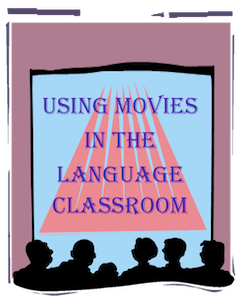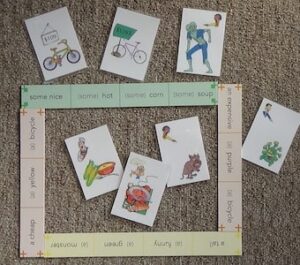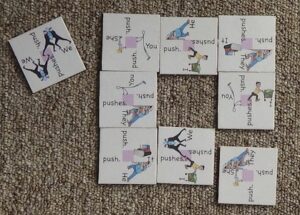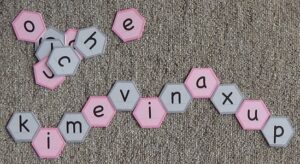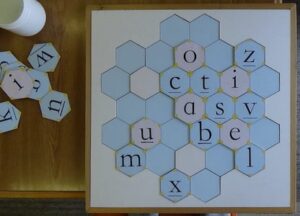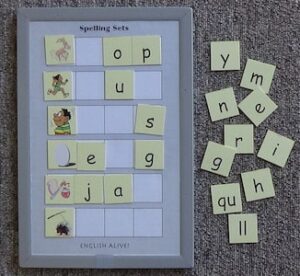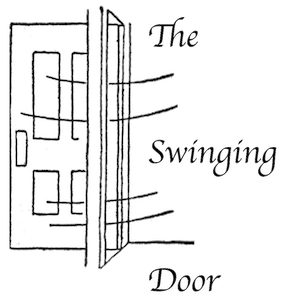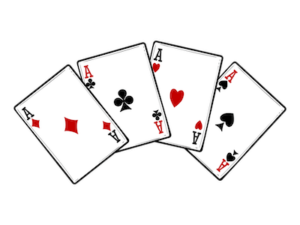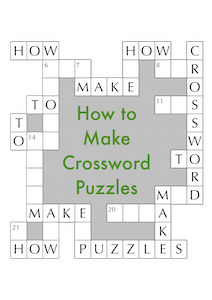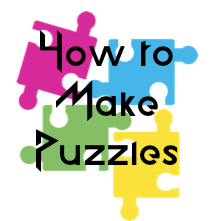Teacher Resources
FIVE GREAT GAMES
Here are five games of my own design and devising. If you follow the links, you should find not only an explanation and description of each game, but for most of them printable pages to make it easy for you to make the games to use in your own classroom. For some of them there is even a YouTube video to show you the game in action!
Players have fun practicing the natural order of adjectives in English.
The proper order of adjectives ( e.g., a big, red car rather than a red, big car ) can be a grammatical hobgoblin in English. This unique game gives the learners a chance to acquire it naturally, taking the onerous and the ornery out of it! For the learners, the focus will be on meaning, allowing the grammar to “come in through the back door.”
As they try to solve this deceptively simple 9-piece puzzle, students learn and practice that old bugaboo of English grammar: the third-person singular s: He sits / She sits / It sits).
Players build sentences to describe images. Grammar patterns they already know are reinforced, and new ones are learned.
Like any good puzzle, it’s all about putting the right pieces in the right places! Each set of pieces practices a different verb tense.
Rattlesnake (phonics)
This super-simple phonics activity gives players practice with basic decoding by building and reading strings of letters that grow progressively longer, one letter at a time, in an alternating consonant-vowel pattern.
Stop the game before the children start to tire of it—but you’ll be surprised how long the kids will go at it without losing interest!
Tri-It (phonics)
With this simple board game, players have fun decoding random three-letter C-V-C (consonant-vowel-consonant) words.
When two blue tiles and one pink tile meet at a common point, the player (or the player in unison) reads aloud one or both of the C-V-Cs that are formed.
Great for learners just beginning to decode C-V-Cs.
WONDERFUL ONE-OFFS
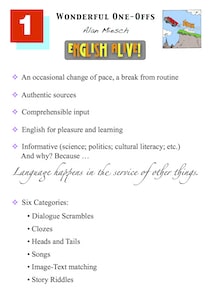
What I call a “one-off” is a learning task or activity that is not expected to be an on-going project or a part of a larger progressive syllabus. It is an engaging diversion from the usual lesson plan, something that is you use once, and you are done with it.
It could be something that you will carry out over the course of a few lessons, but usually it will take up no more than a portion of one class session.
Learners unscramble the component pieces of a dialogue while listening to the source audio or video. To accomplish the task, they listen intently and think about meaning and grammar—all in one engaging activity!
Here are some ideas to help make cloze exercises (also known as “fill-in-the-blank exercises) more engaging and pedagogically productive!
You can use songs, poems, news articles—even the text of your usual syllabus.
But don’t stop there! Spice up the old “fill-in-the-blank” routine with fresh, engaging challenges embedded into the task.
Get your learners to stop fretting about grammar by beguiling them with fascinating trivia and factoids, proverbs, famous quotations, one-liner jokes and more. (The Internet is chock-full of treasures like these!)
Break the sentences into pieces, and as the learners work together to match the pieces, they will be exposed to vocabulary, spelling, and grammar—but all the time their primary focus will be on meaning.
What more magical a way is there to expose your learners (of all ages!) to natural, authentic language than through songs? And there are so many ways you can use songs for language learning: clozes, discovering rhyme schemes, vocabulary matching, crossword puzzles, lyric scrambles, discussion questions, and more!
Here are some ways I have used songs in my classroom.
Capture your students’ interest with visually arresting images, then challenge them to find out more about the images by matching them with textual passages.
Done right, this is not only high interest, but also makes the language affiliated with the images accessible.
Your learners will be laser focused on meaning when they put on their thinking caps to solve brain teasers. They will be reading, speaking, and listening carefully as they work together, reading clues to each other and interrogating the answer holder. The stories are often amusing, always engaging!
Five Fabulous Favorites
Five classroom activities
that are among the favorites
for me and for my students!

Using Movies
in the Language Classroom